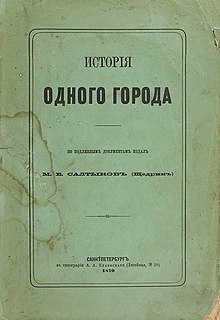The History of a Town
 First edition | |
| Author | Mikhail Saltykov-Shchedrin |
|---|---|
| Original title | Исторiя одного города |
| Country | Russia |
| Language | Russian |
| Genre | Satirical novel, political novel |
| Publisher | Otechestvennye Zapiski |
Publication date | 1870 |
The History of a Town (pre-reform Russian: Исторiя одного города; post-reform Russian: История одного города, tr. Istoriya odnogo goroda) is a 1870 novel by Mikhail Saltykov-Shchedrin. It is regarded by critics as a satirical masterpiece and sometimes compared to Gabriel García Márquez's One Hundred Years of Solitude.[1]
Background[]
In the 1867-1868 Saltykov-Shchedrin stopped working upon the cycle of satirical sketches The Pompadours and started upon the novel, seeing it a kind of a spin-off for the cycle. In January 1869 the two first chapters appeared in the No.1 issue of Otechestvennye Zapiski magazine. A pause followed and lasted till the end of the year: the author wrote and published several satirical fairytales (such as "The Story of How a Muzhik fed two generals") and satirical sketches. The rest of the novel was published in issues in 1870. The last chapter of the novel, which describes the rule of Ugryum-Burcheev, was impressed by the murder of Ivan Ivanov by the socialist revolutionary group "People's Vengeance".[2]
Plot[]
The novel presents a fictional chronicle (letopis) of a provincial Russian town of Glupov (the name can be translated as Foolsville, Foolov, or Stupidtown), which depicts Glupov and its governors from its foundation by the tribe of Headbeaters to its end in 1825 (the accession of Nicholas I). Among the governors of Glupov are Dementy Brudasty, nicknamed The Music Box for a mechanical device in his head, designed to replace a human brain; Vasilisk Borodavkin, who wages 'the wars of enlightenment' against the Glupovites; Erast Grustilov, a friend of Nikolay Karamzin. All of them are trying to bring prosperity to Glupov or to keep their status by ruling the town in their own way, mostly by violence. The last governor of Glupov is Ugryum-Burcheev, who rebuilds the town into a totalitarian state according the administrative ideal of Russian Empire and to his utopia of a 'straight line', intended to make everyone equal. His rule results with the coming of "it", which destroys Glupov, making the history "to cease its course".
Reception[]
There is something of Swift in Saltykoff; that serious and grim comedy, that realism — prosaic in its lucidity amidst the wildest play of fancy — and, above all, that constant good sense — I may even say that moderation — kept up in spite of so much violence and exaggeration of form. I have seen audiences thrown into convulsions of laughter by the recital of some of Saltykoff’s sketches. There was something almost terrible in that laughter, the public, even while laughing, feeling itself under the lash. I repeat that the History of a Town could not be translated as it stands, but I think that a selection might be made out of the different forms of its Governors which pass before the reader’s eyes, sufficient of give an idea to foreigners of the interest excited in Russia by a strange and striking book — one which, under a form necessarily allegorical, offers a picture of Russian history which is, alas! too true.

Style[]
Because of his grotesque satire and fantasy, Saltykov is often compared to Nikolai Gogol. He is also similar with his semantic manipulation. However, Saltykov is different with his 'grim single-mindedness', which is seen in uncharacteristic of Gogol crude and some times erotic (for example, the town-governesses 'ate babies, cut off women’s breasts and ate them too') scenes of violence, death and "repression for repression’s sake". Virginia Llewellyn Smith notes: "Unlike Gogol, Saltykov never gives the impression that he himself scarcely distinguished fantasy from reality, and one result is that his narrative has moments of genuine pathos."
In The History of a Town, a parody of Russian chronicles, Saltykov satirizes the style of official documents and chronicles. For example, the scene of Headbeaters drowning in a bog is commented with a phrase 'Many showed zeal for their native land.' He also conveys an impression of insecurity by shifting between from one style to another: the scenes of violence are often written by a style of a realist novel, but then Saltykov reverts to 'the chronicler’s unctuous tones'; harsh realism is changed with fantasy.[4]
Screen adaptations[]
- Organchik (1933), directed by Nikolai Khodataev.
- Ono (1989), directed by Sergei Ovcharov.
- Istoriya odnogo goroda. Organchik (1991), directed by Valentin Karavaev.
English editions[]
- The History of a Town, Willem A. Meeuws, Oxford, 1980. Translated by I. P. Foote ISBN 0902672398
- The History of a Town, translated and annotated by I. P. Foote, foreword by Charlotte Hobson. Head of Zeus, 2016.
- The History of a Town, or, The Chronicle of Foolov, Ardis, 1982. ISBN 0882336118
References[]
- ^ M.E. Saltykov-Shchedrin, I.P. Foote, Charlotte Hobson (2016). The History of a Town. Head of Zeus.
{{cite book}}: CS1 maint: multiple names: authors list (link) - ^ История одного города | Полка
- ^ Ivan Tourguéneff. History of a Town. Edited by M. E. Saltykoff
- ^ Virginia Llewellyn Smith · The Glupovites · LRB 4 September 1980
- 1870 Russian novels
- Novels by Mikhail Saltykov-Shchedrin
- Russian satirical novels
- Russian political satire
- Russian political novels
- Novels about totalitarianism
- Russian novels adapted into films
- Works originally published in Otechestvennye Zapiski